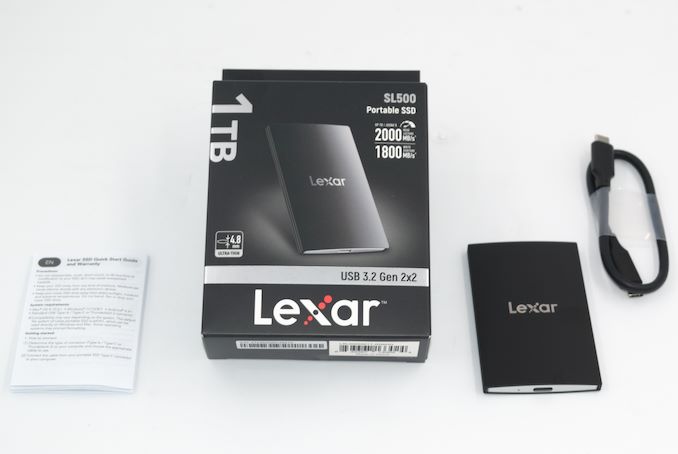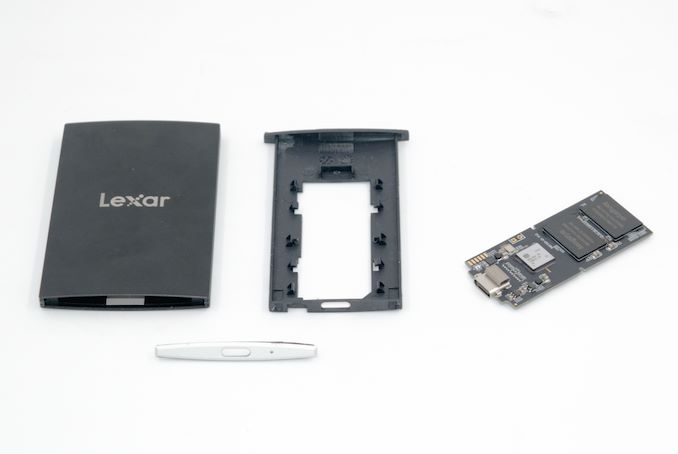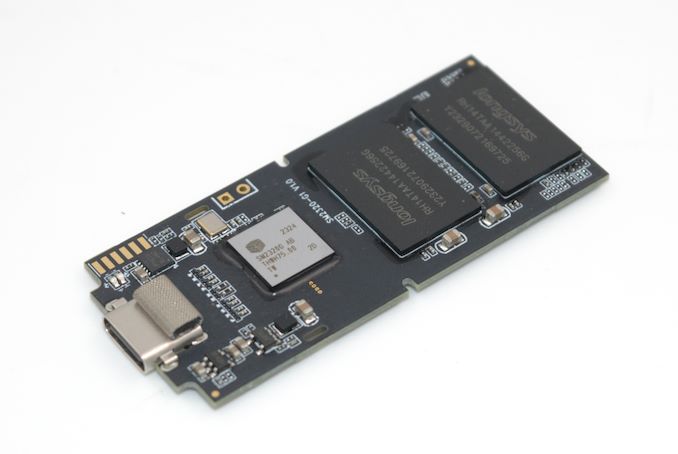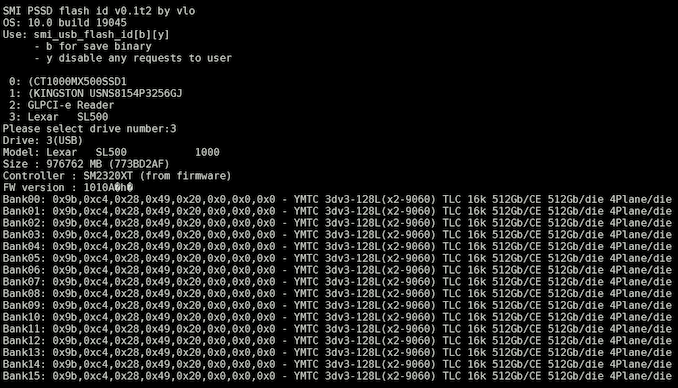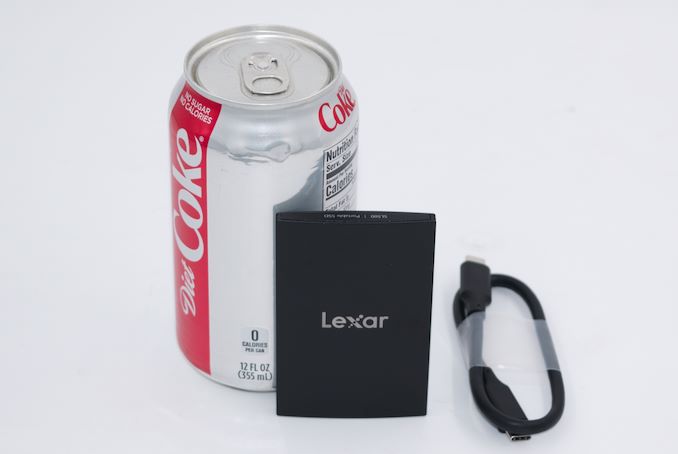
Lexar SL500 Portable SSD Review: Silicon Motion SM2320 and YMTC NAND in a Potent Package
2024-04-23Lexar has a long history of serving the flash-based consumer storage market in the form of SSDs, memory cards, and USB flash drives. After having started out as a Micron brand, the company was acquired in 2017 by Longsys which has diversified its product lineup with regular introduction of new products. Recently, the company announced a number of portable SSDs targeting different market segments. The Lexar SL500 Portable SSD is one of the moderately priced 20 Gbps PSSDs in that set.
The SL500 is able to achieve its price point thanks to the use of a native USB flash controller – the Silicon Motion SM2320. The unique aspect is the use of YMTC 3D TLC NAND (compared to the usual Micron or BiCS NAND that we have seen in previous SM2320-based PSSDs). This review takes a detailed look at the SL500, including an analysis of its internals and evaluation of its performance consistency, power consumption, and thermal profile.
External bus-powered storage devices have been growing in storage capacity as well as access speeds over the last decade. Advancements in flash technology (such as the advent of 3D NAND and NVMe) and the evolution of faster host interfaces (such as Thunderbolt 3 and USB 3.x / USB4). As a result, we have been seeing palm-sized flash-based storage devices capable of delivering 3GBps+ speeds. While those speeds can be achieved with Thunderbolt 4, mass-market devices have to rely on USB. Within the USB ecosystem, USB 3.2 Gen 2 (10 Gbps) is fast becoming the entry level for thumb drives and portable SSDs. USB 3.2 Gen 2×2 (20 Gbps) got off to a slow start, but recent computing platforms from both Intel and AMD have started to support it on the host side. The introduction of native USB 3.2 Gen 2×2 flash controllers such as the Phison U18 and Silicon Motion SM2320 has enabled PSSD vendors to bring low-cost power-efficient 20 Gbps external drives to the market.
Broadly speaking, there are currently five distinct performance levels in the PSSD market:
- 2GBps+ drives with Thunderbolt 3 or USB4, using NVMe SSDs
- 2GBps drives with USB 3.2 Gen 2×2, using NVMe SSDs or direct USB flash drive (UFD) controllers
- 1GBps drives with USB 3.2 Gen 2, using NVMe SSDs or direct UFD controllers
- 500MBps drives with USB 3.2 Gen 1 (or, Gen 2, in some cases), using SATA SSDs
- Sub-400MBps drives with USB 3.2 Gen 1, using UFD controllers
Within each of these levels, there is further segmentation into entry-level, mid-range, and premium based on the choice of internal components. The Lexar SL500 we are looking at today falls under the second category. Lexar touts the ultra-thin nature of the PSSD as a key selling point. The packaging itself is spartan – we have a discrete Type-C to Type-C cable, along with an user guide.
The casing is metal and exudes a sleek and premium look. However, there are no claims of ruggedness or any specific IP ratings. The unit does not have any screws and disassembling involves prying off the plastic tabs at either end and pushing out the internal plastic frame.
The plastic frame itself is a bit oversized for the board, but that seems to have been done keeping in mind the need to make the external casing palm-sized. The gallery below presents some insights into the case design and internals of the PSSD.
Interestingly, the board does not have any explicit thermal solution – no thermal pads or conducting paths to the external casing from either the controller or flash packages. The SM2320 UFD controller is directly visible on the board.
The 1TB version includes four flash packages in a double-sided configuration. The packages are from Longsys themselves with no obvious indication of the NAND inside. Fortunately, we have a publicly available NAND decoder tool for Silicon Motion PSSDs, and that reveals the use of YMTC’s 128L 3D TLC inside the packages.
This review compares the Lexar SL500 against a host of other 2GBps-class PSSDs we have reviewed before. An overview of the internal capabilities of these PSSDs is given by CrystalDiskInfo. The SL500 supports full S.M.A.R.T passthrough, along with TRIM to ensure consistent performance for the drive over its lifetime.
| S.M.A.R.T Passthrough – CrystalDiskInfo | |
 |
 |
The table below presents a comparative view of the specifications of the different storage bridges presented in this review.
| Comparative Direct-Attached Storage Devices Configuration | ||
| Aspect | ||
| Downstream Port | Native Flash | 1x PCIe 3.0 x4 (M.2 NVMe) |
| Upstream Port | USB 3.2 Gen 2×2 Type-C (Female) | USB 3.2 Gen 2×2 Type-C |
| Bridge Chip | Silicon Motion SM2320 | ASMedia ASM2364 |
| Power | Bus Powered | Bus Powered |
| Use Case | 2GBps-class, sleek and stylish palm-sized high-performance portable SSD with hardware encryption and a Type-C interface | Premium 2GBps-class, compact, and sturdy portable SSD in a gumstick form-factor targeting the gaming market |
| Physical Dimensions | 85 mm x 54 mm x (4.5 to 7.8) mm | 118 mm x 62 mm x 14 mm |
| Weight | 43 grams | 115 grams (without cable) |
| Cable | 30 cm USB 3.2 Gen 2×2 Type-C (male) to Type-C (male) | 30 cm USB 3.2 Gen 2×2 Type-C to Type-C 30 cm USB 3.2 Gen 2 Type-C to Type-A |
| S.M.A.R.T Passthrough | Yes | Yes |
| UASP Support | Yes | Yes |
| TRIM Passthrough | Yes | Yes |
| Hardware Encryption | Yes | Not Available |
| Evaluated Storage | YMTC 128L 3D TLC (packaged by Longsys) | Western Digital SN750E PCIe 3.0 x4 M.2 2280 NVMe SSD SanDisk / Toshiba BiCS 4 96L 3D TLC |
| Price | $118 | USD 210 |
| Review Link | Crucial X10 Pro 2TB Review | WD_BLACK P50 Game Drive SSD 1TB Review #1 (2020) WD_BLACK P50 Game Drive SSD 1TB Review #2 (2021) |
An interesting aspect of the Lexar SL500 that makes it stand out from the crowd is the availability of 256-bit AES encryption support using Lexar’s custom password-protection software (that needs to be installed on all machines that need access to the contents).
Prior to looking at the benchmark numbers, power consumption, and thermal solution effectiveness, a description of the testbed setup and evaluation methodology is provided.
Testbed Setup and Evaluation Methodology
Direct-attached storage devices (including thumb drives) are evaluated using the Quartz Canyon NUC (essentially, the Xeon / ECC version of the Ghost Canyon NUC) configured with 2x 16GB DDR4-2667 ECC SODIMMs and a PCIe 3.0 x4 NVMe SSD – the IM2P33E8 1TB from ADATA.
The most attractive aspect of the Quartz Canyon NUC is the presence of two PCIe slots (electrically, x16 and x4) for add-in cards. In the absence of a discrete GPU – for which there is no need in a DAS testbed – both slots are available. In fact, we also added a spare SanDisk Extreme PRO M.2 NVMe SSD to the CPU direct-attached M.2 22110 slot in the baseboard in order to avoid DMI bottlenecks when evaluating Thunderbolt 3 devices. This still allows for two add-in cards operating at x8 (x16 electrical) and x4 (x4 electrical). Since the Quartz Canyon NUC doesn’t have a native USB 3.2 Gen 2×2 port, Silverstone’s SST-ECU06 add-in card was installed in the x4 slot. All non-Thunderbolt devices are tested using the Type-C port enabled by the SST-ECU06.
The specifications of the testbed are summarized in the table below:
| The 2021 AnandTech DAS Testbed Configuration | |
| System | Intel Quartz Canyon NUC9vXQNX |
| CPU | Intel Xeon E-2286M |
| Memory | ADATA Industrial AD4B3200716G22 32 GB (2x 16GB) DDR4-3200 ECC @ 22-22-22-52 |
| OS Drive | ADATA Industrial IM2P33E8 NVMe 1TB |
| Secondary Drive | SanDisk Extreme PRO M.2 NVMe 3D SSD 1TB |
| Add-on Card | SilverStone Tek SST-ECU06 USB 3.2 Gen 2×2 Type-C Host |
| OS | Windows 10 Enterprise x64 (21H1) |
| Thanks to ADATA, Intel, and SilverStone Tek for the build components | |
The testbed hardware is only one segment of the evaluation. Over the last few years, the typical direct-attached storage workloads for memory cards have also evolved. High bit-rate 4K videos at 60fps have become quite common, and 8K videos are starting to make an appearance. Game install sizes have also grown steadily even in portable game consoles, thanks to high resolution textures and artwork. Keeping these in mind, our evaluation scheme for portable SSDs and UFDs involves multiple workloads which are described in detail in the corresponding sections.
- Synthetic workloads using CrystalDiskMark and ATTO
- Real-world access traces using PCMark 10’s storage benchmark
- Custom robocopy workloads reflective of typical DAS usage
- Sequential write stress test
In the next section, we have an overview of the performance of the Lexar SL500 in these benchmarks. Prior to providing concluding remarks, we have some observations on the PSSD’s power consumption numbers and thermal solution also.
Benchmarks such as ATTO and CrystalDiskMark help provide a quick look at the performance of the direct-attached storage device. The results translate to the instantaneous performance numbers that consumers can expect for specific workloads, but do not account for changes in behavior when the unit is subject to long-term conditioning and/or thermal throttling. Yet another use of these synthetic benchmarks is the ability to gather information regarding support for specific storage device features that affect performance.
Lexar claims read and write speeds of 2000 MBps and 1800 MBps respectively, and these are backed up by the ATTO benchmarks provided below. ATTO benchmarking is restricted to a single configuration in terms of queue depth, and is only representative of a small sub-set of real-world workloads. It does allow the visualization of change in transfer rates as the I/O size changes, with optimal performance being reached around 512 KB for a queue depth of 4.
| ATTO Benchmarks | |
| TOP: | BOTTOM: |
 |
|
CrystalDiskMark, on the other hand, uses four different access traces for reads and writes over a configurable region size. Two of the traces are sequential accesses, while two are 4K random accesses. Internally, CrystalDiskMark uses the Microsoft DiskSpd storage testing tool. The ‘Seq128K Q32T1’ sequential traces use 128K block size with a queue depth of 32 from a single thread, while the ‘4K Q32T16’ one does random 4K accesses with the same queue configuration, but from multiple threads. The ‘Seq1M’ traces use a 1MiB block size. The plain ‘Rnd4K’ one uses only a single queue and single thread . Comparing the ‘4K Q32T16’ and ‘4K Q1T1’ numbers can quickly tell us whether the storage device supports NCQ (native command queuing) / UASP (USB-attached SCSI protocol). If the numbers for the two access traces are in the same ballpark, NCQ / UASP is not supported. This assumes that the host port / drivers on the PC support UASP.
| CrystalDiskMark Benchmarks | |
| TOP: | BOTTOM: |
 |
|
 |
|
UASP and NCQ are supported, allowing the PSSD to deliver true SSD-like performance for random accesses. The sequential numbers and random reads are a notch higher for the SL500 compared to the X10 Pro, but the random writes are slightly worse off. This points to the ability of the SM2320 to be optimized for different performance profiles. Since the base platform is a DRAM-less NVMe SSD, the random access numbers are not going to be as good as what can be obtained with bridge-based solutions that adopt a SSD with DRAM for the flash translation layer (such as the WD_BLACK P50).
AnandTech DAS Suite – Benchmarking for Performance Consistency
Our testing methodology for storage bridges / direct-attached storage units takes into consideration the usual use-case for such devices. The most common usage scenario is transfer of large amounts of photos and videos to and from the unit. Other usage scenarios include the use of the unit as a download or install location for games and importing files directly from it into a multimedia editing program such as Adobe Photoshop. Some users may even opt to boot an OS off an external storage device.
The AnandTech DAS Suite tackles the first use-case. The evaluation involves processing five different workloads:
- AV: Multimedia content with audio and video files totalling 24.03 GB over 1263 files in 109 sub-folders
- Home: Photos and document files totalling 18.86 GB over 7627 files in 382 sub-folders
- BR: Blu-ray folder structure totalling 23.09 GB over 111 files in 10 sub-folders
- ISOs: OS installation files (ISOs) totalling 28.61 GB over 4 files in one folder
- Disk-to-Disk: Addition of 223.32 GB spread over 171 files in 29 sub-folders to the above four workloads (total of 317.91 GB over 9176 files in 535 sub-folders)
Except for the ‘Disk-to-Disk’ workload, each data set is first placed in a 29GB RAM drive, and a robocopy command is issue to transfer it to the external storage unit (formatted in exFAT for flash-based units, and NTFS for HDD-based units).
robocopy /NP /MIR /NFL /J /NDL /MT:32 $SRC_PATH $DEST_PATH
Upon completion of the transfer (write test), the contents from the unit are read back into the RAM drive (read test) after a 10 second idling interval. This process is repeated three times for each workload. Read and write speeds, as well as the time taken to complete each pass are recorded. Whenever possible, the temperature of the external storage device is recorded during the idling intervals. Bandwidth for each data set is computed as the average of all three passes.
The ‘Disk-to-Disk’ workload involves a similar process, but with one iteration only. The data is copied to the external unit from the CPU-attached NVMe drive, and then copied back to the internal drive. It does include more amount of continuous data transfer in a single direction, as data that doesn’t fit in the RAM drive is also part of the workload set.
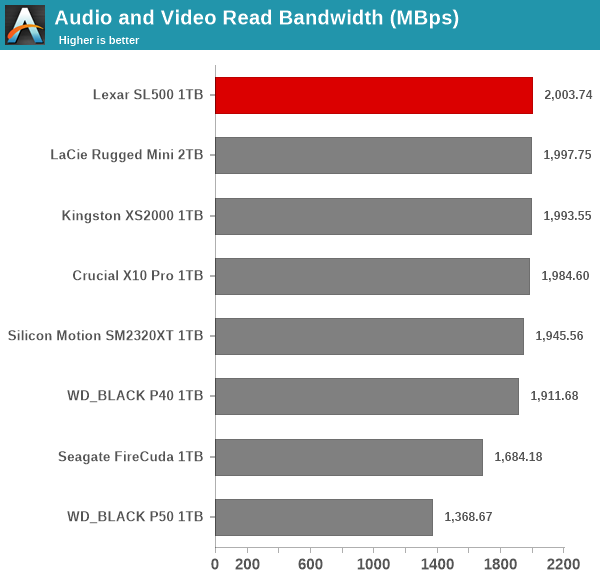
It can be seen that there is no significant gulf in the numbers between the different units for read-heavy workloads. However, for pure writes and mixed workloads, the SL500 find itself in the middle of the pack. For all practical purposes, the casual user will notice no difference between them in the course of normal usage. However, power users may want to dig deeper to understand the limits of each device. To address this concern, we also instrumented our evaluation scheme for determining performance consistency.
Performance Consistency
Aspects influencing the performance consistency include SLC caching and thermal throttling / firmware caps on access rates to avoid overheating. This is important for power users, as the last thing that they want to see when copying over 100s of GB of data is the transfer rate going down to USB 2.0 speeds.
In addition to tracking the instantaneous read and write speeds of the DAS when processing the AnandTech DAS Suite, the temperature of the drive was also recorded. In earlier reviews, we used to track the temperature all through. However, we have observed that SMART read-outs for the temperature in NVMe SSDs using USB 3.2 Gen 2 bridge chips end up negatively affecting the actual transfer rates. To avoid this problem, we have restricted ourselves to recording the temperature only during the idling intervals. The graphs below present the recorded data.
| AnandTech DAS Suite – Performance Consistency | |
| TOP: | BOTTOM: |
 |
|
 |
|
The first three sets of writes and reads correspond to the AV suite. A small gap (for the transfer of the video suite from the internal SSD to the RAM drive) is followed by three sets for the Home suite. Another small RAM-drive transfer gap is followed by three sets for the Blu-ray folder. This is followed up with the large-sized ISO files set. Finally, we have the single disk-to-disk transfer set. The SL500 exhibits remarkable consistency across all of the RAM drive transfer sets. In the disk-to-disk test, the performance profile is similar to that of the other SM2320-based PSSDs. The write speeds are a bit behind other configurations such as the Crucial X10 Pro, and this seems to allow for maintenance of higher transfer speeds across an extended time duration compared to the other units. The write speeds occasionally drop down to around 100 MBps after the SLC cache runs out and the unit is subject to high stress levels in the disk-to-disk segment, but the SL500 is no worse than other similar PSSDs in this aspect. Interestingly, the peak temperature noted in the above workload was only 58C despite the absence of any explicit thermal solution.
There are a number of storage benchmarks that can subject a device to artificial access traces by varying the mix of reads and writes, the access block sizes, and the queue depth / number of outstanding data requests. We saw results from two popular ones – ATTO, and CrystalDiskMark – in a previous section. More serious benchmarks, however, actually replicate access traces from real-world workloads to determine the suitability of a particular device for a particular workload. Real-world access traces may be used for simulating the behavior of computing activities that are limited by storage performance. Examples include booting an operating system or loading a particular game from the disk.
PCMark 10’s storage bench (introduced in v2.1.2153) includes four storage benchmarks that use relevant real-world traces from popular applications and common tasks to fully test the performance of the latest modern drives:
- The Full System Drive Benchmark uses a wide-ranging set of real-world traces from popular applications and common tasks to fully test the performance of the fastest modern drives. It involves a total of 204 GB of write traffic.
- The Quick System Drive Benchmark is a shorter test with a smaller set of less demanding real-world traces. It subjects the device to 23 GB of writes.
- The Data Drive Benchmark is designed to test drives that are used for storing files rather than applications. These typically include NAS drives, USB sticks, memory cards, and other external storage devices. The device is subjected to 15 GB of writes.
- The Drive Performance Consistency Test is a long-running and extremely demanding test with a heavy, continuous load for expert users. In-depth reporting shows how the performance of the drive varies under different conditions. This writes more than 23 TB of data to the drive.
Despite the data drive benchmark appearing most suitable for testing direct-attached storage, we opt to run the full system drive benchmark as part of our evaluation flow. Many of us use portable flash drives as boot drives and storage for Steam games. These types of use-cases are addressed only in the full system drive benchmark.
The Full System Drive Benchmark comprises of 23 different traces. For the purpose of presenting results, we classify them under five different categories:
- Boot: Replay of storage access trace recorded while booting Windows 10
- Creative: Replay of storage access traces recorded during the start up and usage of Adobe applications such as Acrobat, After Effects, Illustrator, Premiere Pro, Lightroom, and Photoshop.
- Office: Replay of storage access traces recorded during the usage of Microsoft Office applications such as Excel and Powerpoint.
- Gaming: Replay of storage access traces recorded during the start up of games such as Battlefield V, Call of Duty Black Ops 4, and Overwatch.
- File Transfers: Replay of storage access traces (Write-Only, Read-Write, and Read-Only) recorded during the transfer of data such as ISOs and photographs.
PCMark 10 also generates an overall score, bandwidth, and average latency number for quick comparison of different drives. The sub-sections in the rest of the page reference the access traces specified in the PCMark 10 Technical Guide.
Booting Windows 10
The read-write bandwidth recorded for each drive in the boo access trace (that is the tag given in the official PCMark technical guide) is presented below.

The SL500 can’t match the performance of the PSSDs with DRAM-equipped internal drives. However, among the native controller-based unit, the SL500 comes out on top. Booting OSs requires good random access performance for small-sized accesses, and it is no surprise that using DRAM for FTL works better in that case.
Creative Workloads
The read-write bandwidth recorded for each drive in the sacr, saft, sill, spre, slig, sps, aft, exc, ill, ind, psh, and psl access traces are presented below.
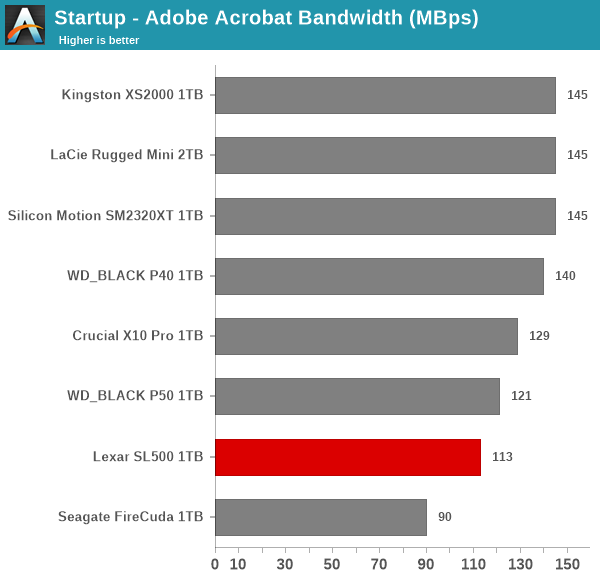
Bridge-based solutions perform better for creative workloads, while the native controller solutions perform similarly. The SL500 NAND and firmware configuration has some restrictions on the peak write speeds compared to other SM2320-based drives, and the net result is that the SL500 appears in the lower half of the compared drives across almost all of the components.
Office Workloads
The read-write bandwidth recorded for each drive in the exc and pow access traces are presented below.
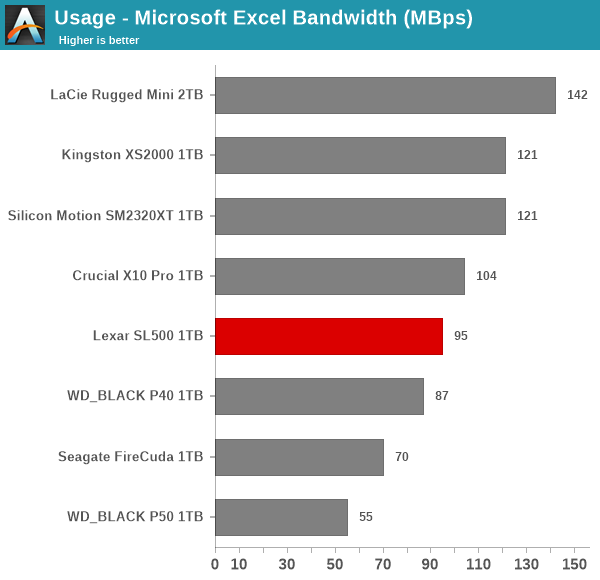
Offce workloads do not tend to favor the brdige-based / DRAM-equipped drives, but the SL500’s firmware configuration tends to push it towards the lower half of the pack for both Excel and Powerpoint traces.
Gaming Workloads
The read-write bandwidth recorded for each drive in the bf, cod, and ow access traces are presented below.
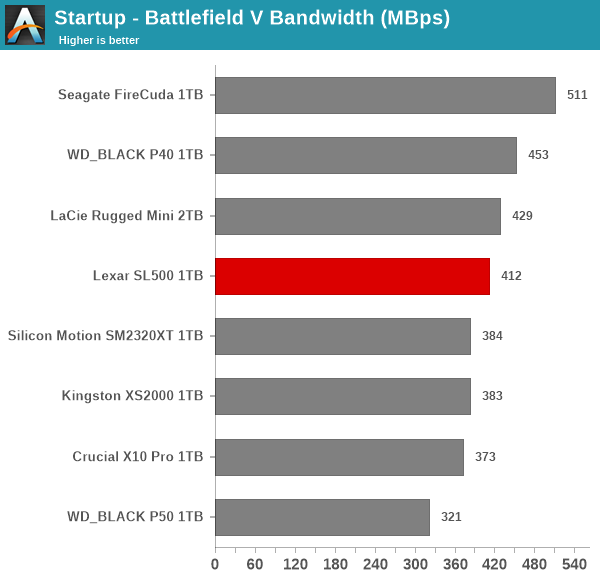
Game startup workloads are read-heavy with a large number of sequential accesses. Under these conditions, most PSSDs in the same speed class perform similarly. The SL500 manages to put itself in the middle of the pack and performance against other SM2320-based PSSDs is hard to differentiate.
Files Transfer Workloads
The read-write bandwidth recorded for each drive in the cp1, cp2, cp3, cps1, cps2, and cps3 access traces are presented below.

The file transfer workloads evaluate the same scenario as our custom DAS suite, and we find the relative ordering of the different PSSDs to be very similar.
Overall Scores
PCMark 10 reports an overall score based on the observed bandwidth and access times for the full workload set. The score, bandwidth, and average access latency for each of the drives are presented below.

The Lexar SL500 makes its mark in the lower half of the pack in the overall PCMark 10 Storage Bench scores. Being held back at 1800 MBps writes because of the NAND and firmware configuration is one of the main reasons, but the loss in performance is offset by other factors discussed in the next section.
The performance of the storage bridges / drives in various real-world access traces as well as synthetic workloads was brought out in the preceding sections. We also looked at the performance consistency for these cases. Power users may also be interested in performance consistency under worst-case conditions, as well as drive power consumption. The latter is also important when used with battery powered devices such as notebooks and smartphones. Pricing is also an important aspect. We analyze each of these in detail below.
Worst-Case Performance Consistency
Flash-based storage devices tend to slow down in unpredictable ways when subject to a large number of small-sized random writes. Many benchmarks use that scheme to pre-condition devices prior to the actual testing in order to get a worst-case representative number. Fortunately, such workloads are uncommon for direct-attached storage devices, where workloads are largely sequential in nature. Use of SLC caching as well as firmware caps to prevent overheating may cause drop in write speeds when a flash-based DAS device is subject to sustained sequential writes.
Our Sequential Writes Performance Consistency Test configures the device as a raw physical disk (after deleting configured volumes). A fio workload is set up to write sequential data to the raw drive with a block size of 128K and iodepth of 32 to cover 90% of the drive capacity. The internal temperature is recorded at either end of the workload, while the instantaneous write data rate and cumulative total write data amount are recorded at 1-second intervals.
| Sequential Writes to 90% Capacity – Performance Consistency | |
| TOP: | BOTTOM: |
 |
|
 |
|
The Lexar SL500 1TB offers a peak speed of 1660 MBps for this access pattern and sustains it for around 23s, pointing to a SLC cache of around 38 GB (actual size is probably a bit smaller, given the background folding in the picture). Beyond that, the drive is able to sustain around 1300 MBps all through. The thermal profile seems satisfactory, given that we only tracked the temperature at the beginning and end of the process. These numbers need to be compared against the Crucial X10 Pro’s 1600 MBps for 600s, and a drop to 1300 MBps after that.
These numbers track our findings in the previous benchmark section. The Lexar SL500 delivers good performance numbers for workloads as long as the SLC cache is in play. Compared to drives that fall down to USB 3.2 Gen 1 speeds under high stress, the SL500 joins the Crucial X10 Pro as one of the few SM2320-based PSSDs capable of sustaining 1 GBps+ numbers for the full span of the drive.
Power Consumption
Bus-powered devices can configure themselves to operate within the power delivery constraints of the host port. While Thunderbolt ports are guaranteed to supply up to 15W for client devices, USB 2.0 ports are guaranteed to deliver only 2.5W (500mA @ 5V). In this context, it is interesting to have a fine-grained look at the power consumption profile of the various external drives. Using the ChargerLAB KM003C, the bus power consumption of the drives was tracked while processing the CrystalDiskMark workloads (separated by 5s intervals). The graphs below plot the instantaneous bus power consumption against time, while singling out the maximum and minimum power consumption numbers.
| CrystalDiskMark Workloads – Power Consumption | |
| TOP: | BOTTOM: |
 |
|
 |
|
Despite the firmware differences, the power consumption profile is remarkably similar for the Lexar SL500, LaCie Rugged Mini, and the Crucial X10 Pro. The SL500 has slightly lower absolute peak numbers (3W vs. 4W), but the PSSD (like other SM2320 solutions) spends most of the time around the 2W mark. Unlike the LaCie Rugged Mini, the Lexar SL500 does have a true deep sleep mode after idling for around 20 minutes.
Final Words
The Lexar SL500 was introduced at CES 2024 along with a host of other PSSD solutions. This Silicon Motion SM2320 solution differentiates itself from other ones in two aspects – usage of YMTC’s 128L 3D TLC and the availability of hardware encryption support. The company seems to be targeting different capacities for different markets. The US market seems to officially only have the 2TB SKU available for $190. The 1TB SKU for $120 ships from the UK. With prices of flash-based storage in a flux, it is not possible to make any comments on the value proposition of the Lexar SL500. However, based on current prices, the Crucial X10 Pro does seem to offer better value for money.
Our only quibbles with the Lexar SL500 are the capping of peak write speeds in the firmware configuration and the absence of a bundled Type-C to Type-A adapter (some vendors supply a cable with an affixed adapter, which is quite welcome when the PSSD is shared across multiple systems). Lexar does have other 2GBps-class PSSDs that reach 2000 MBps write speeds, but the SL500 is limited to 1800 MBps. It is not clear if this is a function of the NAND alone. On the plus side, the power consumption and heat generation are considerably lower compared to other SM2320 PSSDs. This means lesser BOM cost related to thermals.
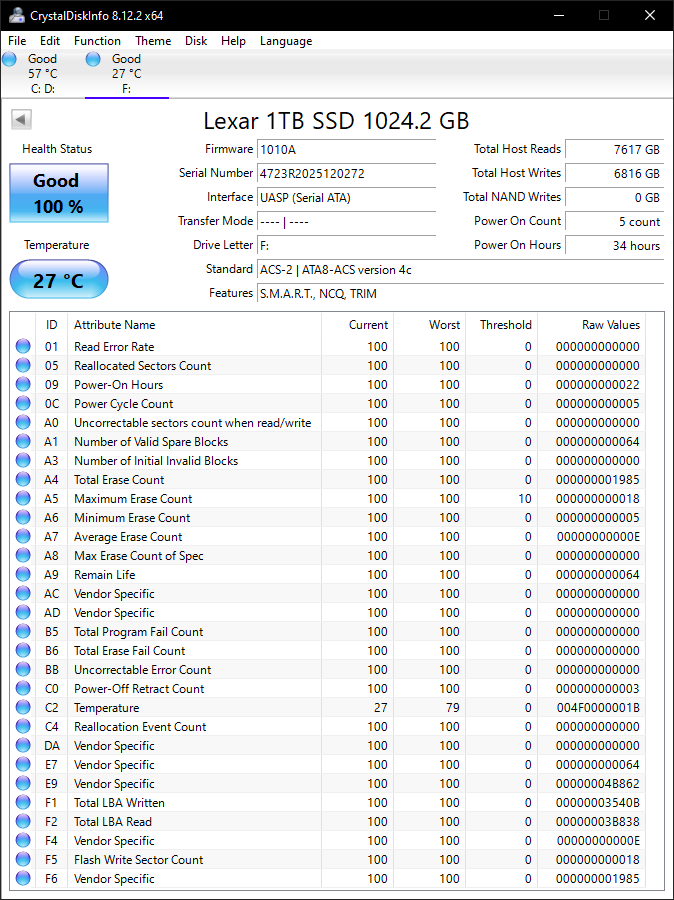
6.8TB+ writes, and 7.6TB+ reads at the end of our testing routine
The design of the casing is subjectively much better than some of the other SM2320-based PSSDs, and the company is right in stressing the ultra-thin nature of the PSSD in its marketing message. The SLC cache size at 38 GB is acceptable for most consumer / casual user workloads. In any case, the direct-to-TLC writes are also quite good at 1.3 GBps. Overall, this is a win for direct-attached storage workloads. On the general usage front, the random access numbers and the behavior for mixed workloads are a bit off – but it is unfair for consumers to expected native controller solutions to perform as well as bridge-based solutions using DRAM-equipped SSDs in that aspect. Overall, the Lexar SL500 shows the flexibility offered by Silicon Motion’s SM2320 solution in good light. Depending on the exact use-case, consumers may find it a good alternative to the Crucial X10 Pro, LaCie Rugged Mini, or the Kingston XS2000.
